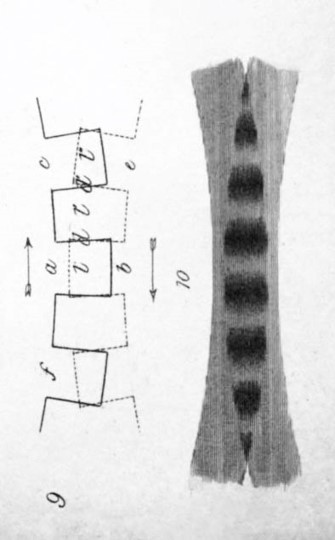
 |
Figure 1 – Spectral Objects. |
| From Faraday, Michael. Figures 9 and 10 in “On a Peculiar Class of Optical Deception.” Journal of the Royal Institution 1 (1831): 205–23. |
In the early 19th century machines in factories and railways started making illusory images. Or so it seemed to scientists like Peter Mark Roget, Michael Faraday and Joseph Plateau who described "spectral" objects and motions like the one in figure 1 caused by the interaction between two moving gears.[1]
They were fascinated because they found the spectres beautiful – a kind of spontaneous machine-art. As empirical scientists they also found them troubling because they believed that the senses are the only way we know the world and machine spectres were deceptions of the senses.
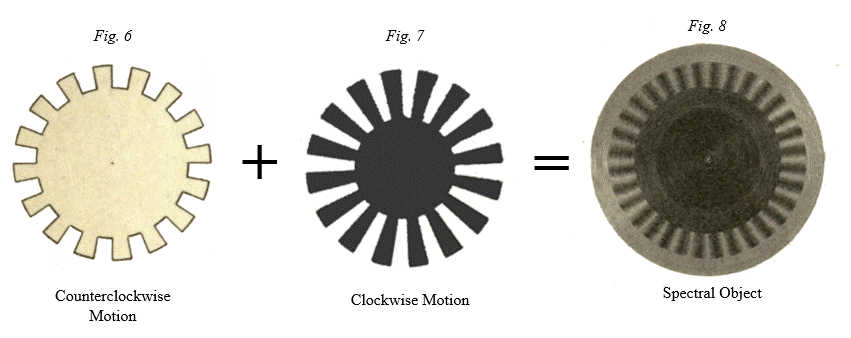 |
Figure 2 – Spectral Objects. |
| From Faraday. Figures 6 to 8 in “Optical Deception." Faraday's figures 6 and 7 are real objects; figure 8 is an illusion. |
Faraday and Plateau set about independently building experimental devices that would help them understand and control spectral images. They were looking for the hidden logic, preferably one that could be expressed mathematically.[2]
Faraday fitted his first device, his cog-wheel machine, with disks that looked very like the gears and spoked wheels that were their models (figure 2). He viewed the spokes/teeth of one disk through the spokes/teeth of the other. He discovered simple relationships between speeds and directions of the real objects and apparent rest or motion of the deceptive phantom.
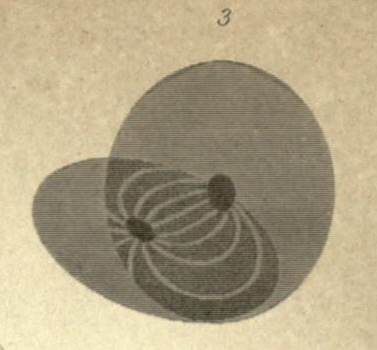 |
Figure 3 – Carriage-Wheel and Shadow. |
| From Faraday. Figure 3 in “Optical Deception.” |
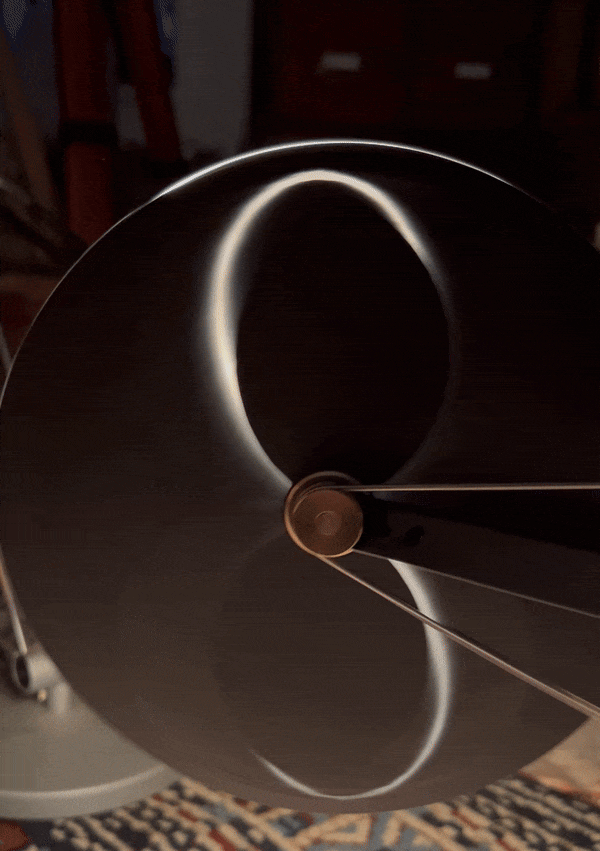 |
Figure 4 – Loci Disks in Motion. |
| Two translucent lines rotating in opposite directions to create a third figure in light. |
Plateau was intrigued by spectral curves, seen here (figure 3) in the interaction of a rolling carriage-wheel and its shadow.
With his brilliant mathematical imagination, he could almost see the equations that would define them. "Loci" is what he called them, meaning that they were spatial figures that could be defined by logical parameters.
A circle is a simple example of a locus and is defined as the set of points (in a given plane) equidistant from a given point. It can also be defined by an apparatus, a set of dividers or compass with one leg pivoting at the centre and the other describing the circumference.
Plateau's loci machine loci machine was a machine for manufacturing loci using two interacting disks with patterns in light upon them (see figure 4). Like Faraday, Plateau tried a variety of disks with various geometric patterns on them. Some produced what he thought were very beautiful figures. I wanted to test his key idea by reproducing a locus that has a known equation.
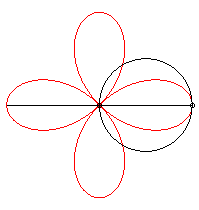 |
Figure 5 – Quatrefoil |
That is the quatrefoil in figure 5. You can graph it with the equation (x2 + y2)3 = 4a2x2y2. Figure 5 illustrates how it can be drawn by the intersection of a line and a circle rotating in opposite directions.
Plateau's machine will make the quatrefoil when fitted with a disk with a straight line cut through the centre and a disk with a circle cut between centre and outside edge. A light shines through the lines from behind and as the intersection changes, that light becomes a moving point. The loci machine draws figures in light in the same way that you can with a glowing coal in the dark.
If you were to take a snapshot of the moving light or the bright coal on the end of your fire-stick it would be a stationary point of light. Why do we see it as a full geometric figure?
Scientists in the 1830s thought that, once stimulated by light, the nerves on the retina stay active for a fraction of a second.[3] If the light moves fast enough to trace the full figure during that time, then the eye will have on it a complete "picture" of the traced line.
In this way the troubling spectre is tied to an objective reality (the path of excited nerves on the retina) that can be captured by a mathematical equation.
Sadly, it turns out not to be as simple as that. The "picture" in figure 4 drifts and changes shape in an unstable fashion. This figure (using different disks spinning at different speed ratios than the quatrefoil) is more typical of what the loci machine produces. Asking why opens up a whole new set of problems.
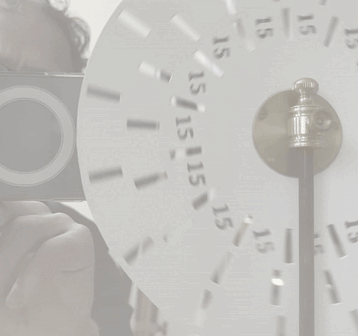 |
Figure 6 – Animated Shutter Disk |
| We are looking through the outer band of 16 slits at a mirror reflection of the disk. |
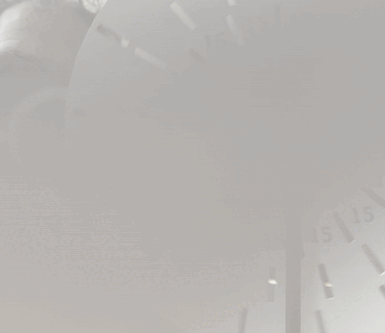 |
Figure 7 – Animated Shutter Disk |
| We are looking through the middle band of 18 slits at a mirror reflection of the disk. |
Faraday designed this simple machine that looks at its own reflection. The first band has 16 slits. When you look through it at the reflection of all three slits you see an amazing illusion (figure 6). The spectre has a mathematical logic that you can think about. Looking through the 16-slot band:
What does the reflection of the outer, 16-slit band appear to do?
What does the reflection of the middle, 18-slit band appear to do?
What does the reflection of the inner, 15-slit band appear to do?
In figure 7 we are looking through the middle, 18-slot band:What does the reflection of the outer, 16-slit band appear to do?
What does the reflection of the middle, 18-slit band appear to do?
What does the reflection of the inner, 15-slit band appear to do?
For Faraday, it is almost as though the machines are telling us something we did not previously know. Once you interact with the machine, he says, explanations "suggest themselves.” What is his Perforated Wheel Machine trying to suggest to us about the secret logic of spectral motion?If you can, like Faraday and Plateau, see the underlying pattern, then you should be able to predict what will happen when you look through the inner, 15-slot band – How will each spectral band behave now? Make your own disk and test to see if you are right.
Faraday expects other serious scientists to build his machines and re-experience what they have shown him. Once Plateau and Faraday have discovered one another's work they begin to attend to the others devices as much as their words.
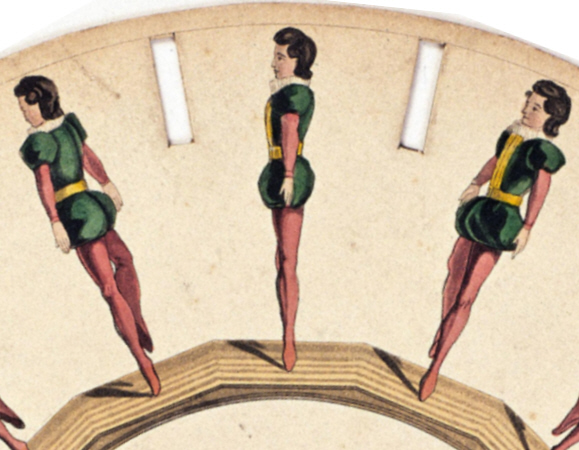 |
Figure 8 – World's First Stop-Motion Animated Image |
| Plateau's hand-drawn images of a dancer on the back of a modified Faraday Perforated Wheel Machine |
Plateau, whose first language was French, appears to have misunderstood Faraday's description of the Perforated Wheel Machine. Instead of slits, he makes the inner two bands as painted images on the back of the disk. Perhaps by accident, he has made the crucial distinction between a shutter (the 16-slit band) and images viewed through a shutter (the painted bands). On my re-creation of the disk I have added an image (the number "15"), so that you can see and anticipate the next possibility that was suggested to Plateau's fertile mind.
Hand-drawn images can be easily altered.
If you painted 16 little dancers standing stiff and straight like the middle figure in figure 8, it would behave like the reflected slit. That is, the 16 moving images would appear as one stationary image. But what if you changed the drawn figure bit by bit as though the dancer were slowly pirouetting?
Plateau's new disk (figure 8) is the very first animation. He has demonstrated the principle on which all later animation, cinema and virtual "reality" is based.[4] The irony is that it was an effort to control the spectral illusions thrown up by machines that has led to the creation of the vast machinery of illusion that in the 21st century distorts so many people's conception of reality.
[1] An Austrian mathematician, Simon Stampfer, independently came up with the idea of animation after reading Faraday's work. See Stampfer, Simon. 1833. Die Stroboscopischen Scheiben; Oder, Optischen Zauberscheiben: Deren Theorie Und Wissenschaftliche Anwendung, Erklärt Von Dem Erfinder [the Stroboscopic Discs; or Optical Magic Discs: Its Theory and Scientific Application, Explained by the Inventor] . Vienna and Leipzig: Trentsensky and Vieweg. Were I able to read German, I might be able to say more about his thinking leading up to his discovery.
[2] See Roget, Peter Mark. 1825. "Explanation of an Optical Deception in the Appearance of the Spokes of a Wheel Seen through Vertical Apertures." Philosophical Transactions of the Royal Society of London 115:131.
[3] This was a materialist way of understanding "persistence of vision." We do experience the phenomenon of persistence, but it is a mental construction (some would want to say a neurological event in the brain), not a picture on the retina.
[4] We might say that Plateau invented cinema. But bear in mind that all claims about individual inventors are essentially arbitrary. First, inventions always emerge from conversations among a number of people (e.g. Roget, Faraday, Plateau). Second, "invention" is always a cumulative and ongoing process of innovations. (As a technical mediation, cinema today is a radically different "invention" from what it was in the "classic" early 20th-century cinema.) Cutting that continuum to say "here is the beginning" is often a post-hoc intervention to privilege a preferred individual or national innovation (e.g. animation as I have suggested here, or the linear narrative form made possible by the invention of translucent images on a celluloid strip that we have come to associate with "film").